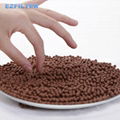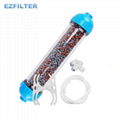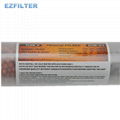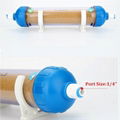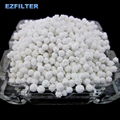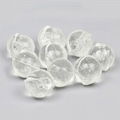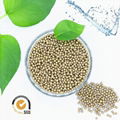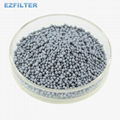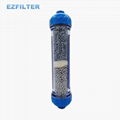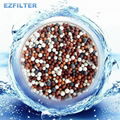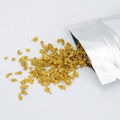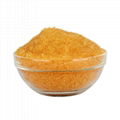| Model: | EZF-AAB |
|---|---|
| Brand: | EZFILTER |
| Origin: | Made In China |
| Category: | Consumer Electronics & Lighting / Water Softener and Purifier |
| Label: | Activated Alumina , Ceramic Ball , Remove Fluoride |
| Price: |
US $45
/ Kilogram
|
| Min. Order: | 1 Kilogram |
| Last Online:24 Oct, 2017 |
Activated Alumina Ceramic Ball Efficiently Remove Fluoride For Water Filter/Water Purifer
Activated Alumina Features and Benefits
1.Activated alumina is also widely used to remove fluoride from drinking water. In the US, there are widespread programs to fluoridate drinking water. However, in certain regions, such as the Jaipur region of India, there is enough fluorine in the water to cause fluorosis. Activated alumina filters can easily reduce fluoride levels from .5 ppm to less than .1 ppm. The amount of fluoride leached from the water being filtered depends on how long the water is actually touching the alumina filter media. Basically, the more alumina in the filter, the less fluoride will be in the final, filtered water. Lower temperature water, and lower pH water (acidic water) are filtered more effectively too.
2.Low abrasion for less dusting during tower depressurization or loading, low pressure drop, and a reduced chance of pl ing the after-filter
3.Resistant to liquid water - Activated Alumina will not shrink, swell, soften or disintegrate when immersed in water. Water sl ing will not fracture the alumina beads. High adsorption capacity of the desiccant can be restored after complete regeneration.
4.High crush strength for minimizing dust formation while loading desiccant into dryer towers. This feature also enables activated alumina to be used as a pre-bed material when other types of desiccants are needed.
5.Uniform bead size of Activated Alumina provides low pressure drop to minimize channeling and ensures utilization of the full bed column section
6.In regenerative drying systems, activated alumina beds have long service life.

Uses of activated alumina
1.Activated alumina can be used as a point-of-entry or point-of-use water treatment device. Activated alumina absorbs contaminants instead of filtering them. The effectiveness of activated alumina depends on the contaminant, characteristics of the alumina, the device design, and water quality.
2.Activated alumina can be an effective treatment method for source water with a high total dissolved solids level, or sulfate concentration. However, a serious drawback to using activated alumina is that regenerating it requires the use of strong acid and base solutions that are undesirable for home storage and handling.

How activated alumina works
1.Activated alumina devices contain a packed bed of activated alumina granules. As water passes through the device, certain contaminants are adsorbed to the activated alumina granules.
2.The effectiveness of activated alumina depends on the chemical form of the contaminant to be removed. For example, under certain circumstances chlorinating the water before activated alumina treatment will convert arsenic into the form most likely to be adsorbed by activated alumina.
3.The success of activated alumina treatment is pH dependent. In general, the water pH should be less than 8.5. For fluoride, a pH between 5 and 6 is optimum. For arsenic, a pH of 7 is recommended. Pretreatment to reduce pH may be necessary for activated alumina to be effective.
4.When the untreated water contains suspended solids, pretreatment with a 5-micron cartridge sediment filter is required to prevent clogging of the activated alumina bed. In addition, if iron and manganese are present, their concentrations should be below the EPA Secondary Drinking Water Standards of 0.3 mg/L for iron and 0.05 mg/L for manganese.

why use Activated Alumina Process Media
Activated alumina is used for a wide range of adsorbent and catalyst applications including the adsorption of catalysts in polyethylene production, in hydrogen peroxide production, as a selective adsorbent for many chemicals including arsenic, fluoride, in sulfur removal from gas streams (Claus Catalyst process).


